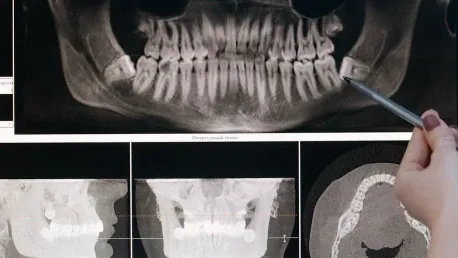The adoption of MONAI Deploy by Siemens Healthineers, as announced by NVIDIA at the Radiological Society of North America’s annual meeting, marks a significant advancement in the integration of AI into medical imaging workflows. This initiative aims to bridge the gap between AI research and clinical production, fundamentally transforming the capabilities of medical imaging by accelerating AI integration processes and streamlining clinical workflow applications. By leveraging MONAI Deploy, Siemens Healthineers seeks to enhance the efficiency of AI model deployment, allowing healthcare professionals to utilize cutting-edge technologies more effectively in their daily work.
Medical imaging plays a crucial role in diagnostic processes worldwide, with an estimated 3.6 billion tests conducted annually, including X-rays, CT scans, MRIs, and ultrasounds. These procedures are essential for diagnosing, monitoring, and treating various conditions. Given the vast number of such procedures, there’s an urgent need to expedite the evaluation and processing of these medical images to aid doctors in managing their workloads efficiently while improving health outcomes. This necessitated the introduction of MONAI by NVIDIA, an open-source platform fostering AI applications within medical imaging and beyond. With MONAI, healthcare professionals have access to a robust, comprehensive AI toolset that can significantly improve diagnostic accuracy and workflow efficiency.
The Role of MONAI in Medical Imaging
MONAI serves as a developmental and research platform, connecting doctors with data scientists. This collaboration leverages vast medical data to build deep learning models essential for developing deployable applications. These applications play a pivotal role within medical AI workflows, bringing transformative capabilities to clinical settings. MONAI Deploy specifically caters to integrating AI research into clinical production by packaging, testing, deploying, and running AI applications within clinical environments. This smooth integration reduces the time and effort traditionally required for such advancements, resulting in a more streamlined approach to deploying AI solutions in healthcare.
Given its expansive potential, Siemens Healthineers, a global leader in medical devices with over 15,000 installations, has opted to incorporate MONAI Deploy into its Syngo Carbon and syngo.via enterprise imaging platforms. These platforms support clinicians in reading and deriving insights from diverse medical images. Historically, developers utilized a myriad of frameworks to build AI applications, complicating the deployment of these applications into clinical environments. However, MONAI Deploy, with just a few lines of code, simplifies this entire process by building AI applications that can run anywhere. This capability vastly streamlines the development and integration process, enhancing the functionality of medical imaging AI applications within clinical workflows and providing faster results for patient care.
Accelerating AI Integration in Clinical Settings
The integration of MONAI Deploy into Siemens Healthineers’ platforms has dramatically accelerated AI integration. Researchers and developers can now port trained AI models into real-world clinical settings with remarkable speed. Instead of enduring months of rigorous processes, this can be achieved with just a few clicks. This efficiency is particularly beneficial for researchers, startups, and entrepreneurs, enabling quicker transitions of their applications to the hands of radiologists. Consequently, healthcare professionals can leverage these innovative solutions to improve diagnostic accuracy and patient outcomes, showcasing the transformative potential of AI in medical imaging.
Axel Heitland, head of digital technologies and research at Siemens Healthineers, highlighted that accelerating AI model deployment empowers healthcare institutions. They can now leverage and benefit from the latest advancements in AI-based medical imaging more rapidly than before. The ability to quickly tailor AI models and transition innovations from research labs to clinical practice makes these advancements accessible to clinical researchers globally via the syngo.via and Syngo Carbon platforms. These platforms, now enhanced with MONAI-developed apps, streamline AI integration by allowing easy provision and usage via the Siemens Healthineers Digital Marketplace. Users can browse, select, and integrate these apps seamlessly into their clinical workflows, fostering a robust ecosystem for innovation and adoption in the medical imaging field.
MONAI’s Milestones and Latest Updates
Celebrating its five-year anniversary, MONAI has already registered significant milestones, such as over 3.5 million downloads, contributions from 220 global contributors, mentions in over 3,000 publications, 17 MICCAI challenge wins, and integration in multiple clinical products. The latest release, MONAI v1.4, further enhances its utility by providing new opportunities for researchers and clinicians to leverage MONAI’s innovations. This milestone release ensures that both the medical research community and healthcare professionals have access to the latest advancements in AI to improve diagnostic accuracy and workflow efficiency across various medical imaging applications.
Key updates in MONAI v1.4 and related NVIDIA products include new foundation models for medical imaging that are customizable within MONAI and deployable as NVIDIA NIM microservices. Some of the available models—MAISI and VISTA-3D—offer specialized capabilities for generating synthetic 3D CT images and effective CT image segmentation, respectively. Another significant update is the introduction of MONAI Multi-Modal Model (M3), which extends multimodal LLMs with medical AI experts, showcased by the VILA-M3 model available on Hugging Face, providing advanced radiological image copilot performance. These advancements highlight the growing importance of AI in medical imaging and the continued efforts to enhance the capabilities of AI tools used in clinical settings.
Collaborative Efforts and Future Prospects
Siemens Healthineers’ adoption of MONAI Deploy, announced by NVIDIA at the Radiological Society of North America’s annual meeting, signifies a major breakthrough in integrating AI into medical imaging workflows. The initiative aims to bridge the gap between AI research and clinical application, fundamentally transforming medical imaging by accelerating AI integration and streamlining clinical workflows. With MONAI Deploy, Siemens Healthineers enhances AI model deployment efficiency, enabling healthcare professionals to use advanced technologies more effectively in their daily practices.
Medical imaging is crucial in diagnostics worldwide, with around 3.6 billion tests annually, such as X-rays, CT scans, MRIs, and ultrasounds. These tests are vital for diagnosing, monitoring, and treating numerous conditions. Due to the sheer volume of these procedures, there’s a pressing need to speed up evaluation and processing to help doctors manage their workload and improve health outcomes. This urgency led to the creation of MONAI by NVIDIA, an open-source platform promoting AI applications in medical imaging and beyond. MONAI provides healthcare professionals with powerful AI tools that can greatly enhance diagnostic accuracy and workflow efficiency.









